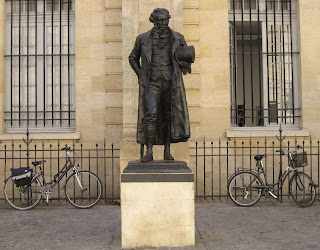All of the subjects covered by Invisible Bordeaux over the past twelve months have been an absolute pleasure to compile and research. It feels wrong to be singling any of them out, but here are five subjects that proved particularly interesting when peeling the layers away! Click on the titles or pictures to read the articles.
The municipal swimming baths in Bègles form one of the most fascinating places in the region. The 1930s art deco building, which was on the verge of being demolished a few years ago, has been totally refurbished, renovated and rejuvenated, the ultra-modern bathing facilities combining nicely with their old-school environment. By following one of the guided tours on the annual national heritage day, Invisible Bordeaux was given a close-up look of all quarters, without even having to get wet or change into swimming trunks.
I have long associated Bordeaux with many things, but until recently bullfighting was not one of them. Traces of the city's substantial bullfighting heritage are virtually invisible to the naked eye: both the longstanding bullring in Le Bouscat and the "temporary" structure to be found in Floirac for 20 years have now been replaced by apartment complexes (although I recently found out from a resident that a surviving section of the arena wall is still tucked away in Le Bouscat). This assignment resulted in a number of long cycle rides, including one that took me out to La Brède to view the place where bullfight meetings continue to be held every year.
Any war-related location is bound to be somewhat disconcerting and Camp De Souge, near Martignas-sur-Jalle, is arguably the most disturbing in the region (although the Natus necropolis near La Teste-de-Buch is a close second). When in the hands of the Germans during the Second World War, Souge was the scene of more than 300 executions. A memorial can now be seen, as can four wooden posts, replicas of those against which the prisoners would have been tied when facing the firing squad. Being alone one autumn morning several kilometres inside military territory was itself an eerie experience, but throw in the sense of history and the wartime legacy of the place, and you get the feeling the air is heavy with the ghosts of its past. This felt like an important subject and a story that needed to be retold.
18th/19th-century Spanish artist Francisco Goya spent the final four years of his life in Bordeaux. He died and was initially buried in the city. I had read bits and bobs about his time here but thought it would be interesting to try and tie the loose ends together and construct a standalone account, hence this item. Having produced the piece, I can now hold a conversation about Goya at dinner parties and remind people that while the remains of his body are now back in Spain, his skull may (or may not) still be in Bordeaux: when Goya's body was exhumed in 1899, his head was missing. It is believed that it was stolen by one of the artist's former models, intent on understanding the workings of Goya's brain by doing
some "hands-on" research.
Many years back I spotted that our family set of the card game "1000 Bornes" had been manufactured in La Teste-de-Buch. Googling the subject, it soon emerged that the game had originated in an Arcachon basement and, throughout its bestselling history, had retained strong ties with the area. Again, a story that deserved to be told and one that was met with a few "well-I-never-knew-that" reactions from acquaintances, which made it all worthwhile!
So that was 2012, here's to another year of hunting high and low for more invisible subjects in and around Bordeaux! Thanks for reading this far and please call again...
So that was 2012, here's to another year of hunting high and low for more invisible subjects in and around Bordeaux! Thanks for reading this far and please call again...
















0 commentaires: